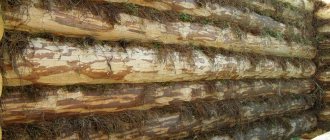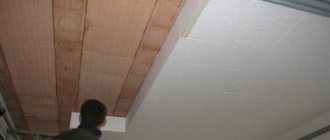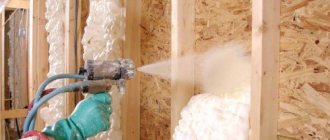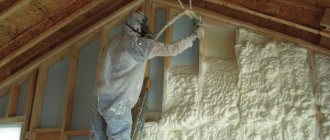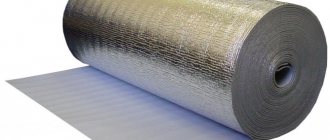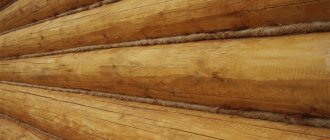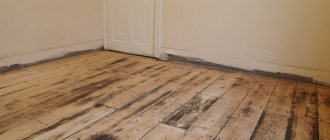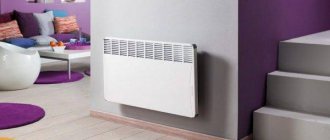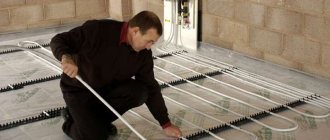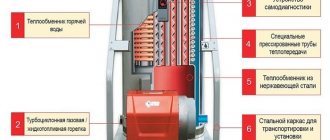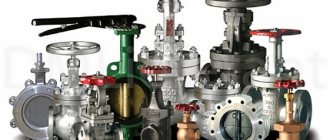Why do you need attic insulation?
In winter and autumn, the temperature difference between indoors and outdoors is strong. All warm air currents tend to the source of cold. This means that in the house they will move towards the walls and roof. Condensation forms at the point of contact between warm and cold masses. It accumulates, causing the material of the walls and ceiling to deteriorate.
In the attic room this is even more noticeable. The pediment and slopes, on one side, are in contact with cold outdoor air, and on the other, with warm indoor air. Thermal insulation is necessary to limit the penetration of warm flow onto cold surfaces.
Choosing insulation for the attic is not difficult. Insulation can be external or internal. External insulation of the building is performed on top of the rafters. The thermal insulation material is covered with a film for waterproofing, and then the roofing material is installed. Such insulation is installed only during construction.
Film for waterproofing Source nohoho.ru
Internal insulation is carried out directly in the room. The insulator is mounted between the rafters and then covered with hydro- and vapor barrier. Installation can be carried out at any time.
Practical tips for installing thermal insulation
Having wisely chosen the optimal thermal insulation material, it is important to install it correctly on the insulated coating. There are many options for laying insulation, the simplest and fastest of which is laying the material between the floor rafters. However, not all roofing structures are suitable for this.
Polyurethane and ecowool have properties such as lightness and the ability to completely fill the space required for insulation, covering the entire required area. For high-quality protection from the cold in the attic, this is an extremely important property.
Using mineral wool, it is cut exactly to the required dimensions, taking into account the width of the rafter pitch. In order to avoid the formation of cold bridges, it is recommended to lay the material in two layers. A prerequisite for using mineral wool is the installation of a waterproofing and vapor barrier layer.
When using hard materials such as polystyrene foam and polystyrene, they are laid not between, but on top of the rafters.
When using these insulation materials, you must fully adhere to the prescribed rules for their installation and follow the entire technological procedure. Due to the fact that the layers of insulation are laid end-to-end, gaps can form, which lead to the formation of “cold bridges”, condensation, temperature changes and the appearance of unwanted microorganisms.
Requirements for insulation
Which insulation is best for an attic roof can be understood by determining the type of room. For high-quality thermal insulation of a bathhouse, you will need insulation that can withstand temperatures of 1000 degrees. But this option is not suitable for summer houses. They often harbor mice that can gnaw all the insulation.
When choosing a material for attic insulation, the following parameters must be taken into account:
- high noise insulation;
- good thermal insulation qualities;
- high service life;
- versatility;
- efficiency;
- water-repellent properties;
- ease of installation.
To understand which insulation for attic walls is better, you should examine each point in more detail.
Even though you can't hear loud neighbors or passing cars on the roof, sound insulation is important. At the first rain or strong wind the noise will be very loud. Especially if the roofing is made of metal profiles or metal tiles. You can save on sound insulation if the attic is non-residential.
Insulation of a metal roof Source tulastroygarant.ru
One of the most important parameters is the degree of thermal conductivity. The lower this indicator, the better the material. The thermal conductivity coefficient must be less than 0.94 W/ms.
To save money, it is better to choose universal insulation. They can insulate both walls and floors with ceilings. If all insulation has the same properties, then it will last the same long time.
The next point is the material from which the supporting structure is made. Not everyone knows which insulation is best for thermal insulation of the attic roof of a wooden house from the inside. Mineral wool or foam wool is suitable for this. These insulators have the highest fire resistance ratings. The more flammable the roof material, the lower the flammability rating of the heat insulator should be.
Insulation of the attic of a wooden house Source gratech-b.com
It is also important to consider what density of insulation is needed for the attic. This figure should be at least 30-40 kg/m³.
The last parameter is hydrophobicity. Water absorption of the material should be as low as possible. The more water accumulates in the insulation, the less it will last.
Comparison of the main characteristics of insulation materials
| Insulation | Density, kg/cub.m | Thermal conductivity*, W/(m*K) | Flammability |
| Minvata | 35 — 40 | 0,035 — 0,039 | NG |
| Glass wool | 15 — 20 | 0,035 — 0,042 | NG |
| Polyurethane foam | 60 — 80 | 0,023 — 0,032 | NG |
| Ecowool | 38 — 41 | 0,038 — 0,041 | G2 |
| Styrofoam | 10 — 37 | 0,033 — 0,041 | G1 |
| Extruded polystyrene foam | 26 — 32 | 0,028 — 0,031 | G4 |
| Sawdust | 0,10 — 0,25 | 0,07 — 0,09 | G3 |
* The lower the value, the better the insulation retains heat.
How to choose insulation
Even if the heat insulator fully complies with the requirements, when purchasing you should take into account the working conditions with it. The specificity of installation work on insulation of attic floors lies in three rules:
- Time for thermal insulation work . Fresh wood is used to construct a wooden attic. Before insulation it must be kept for 6 months. If dry wood is used, at least two weeks should be allowed for aging.
- Determining the required insulator thickness . Heat flows through the roof are much more intense than through the walls or floor. The thickness of a standard heat insulator is 10-12 cm. This is not enough for an attic. With the Russian climate, it is better to use material with a thickness of 30 cm or more. To determine the value of the parameter for certain conditions, you can use a calculator that takes into account the climate, room size, etc.
Thick attic insulation Source guim.co.uk
- Beam design . For ventilation, it is necessary to leave a gap between the insulation and the waterproofing material. Therefore, the height of the profile should be 3-4 cm greater than the thickness of the insulator.
To select a suitable insulation, you should evaluate its properties, guided by these rules.
The main mistakes in attic insulation
When work on insulating an attic from the inside is carried out with your own hands in violation of the technology, already in the first year of operation everything has to be redone.
I have collected for you the typical mistakes of DIY builders.
- Attics with a roof slope of less than 13° are insulated. Such a roof is more susceptible to the negative effects of weather. Snow and rain accumulate on the surface, creating additional stress and high humidity. As a result, cracks, rust, and condensation appear on the inside of the roof.
- Install a layer of thermal insulation close to the roofing material. This creates a greenhouse effect. For proper air circulation, the gap between the roof and the insulating pie should be 3-5 cm.
- Refuse waterproofing or vapor barrier. Moisture accumulates in unprotected insulation and it loses effectiveness.
- The technology for laying membranes is not followed. If insulating materials are laid without overlap and the edges are not secured, moisture can get into the insulation. An increase in humidity in loose insulation materials by even 5% reduces the thermal insulation properties of the material by 20%.
- The thickness of the insulation is incorrectly selected. A layer of insulation thinner than necessary will not provide a sufficient level of thermal protection.
In conclusion, I recommend watching the video instructions, where the master shares some nuances and professional tricks that will help you reliably insulate the room with your own hands.
Modern insulation materials
The most popular insulation materials are mineral wool or fiberglass. But there are also more modern insulation materials that are better used to insulate an attic roof. Each of them requires separate attention.
Glass wool
Glass wool is a fibrous material for thermal insulation. It consists of thin glass threads. It can be produced both in slabs and in rolls. Such insulation is made from quartz sand or broken glass. It has a fairly low thermal conductivity. An important property of glass wool is elasticity. It is suitable for insulating curtain walls and even external insulation.
Glass wool in a roll Source adamson.ua
The advantages of the material include:
- no toxicity when closed;
- will not be damaged by rodents due to the lack of organic components in the composition;
- 2nd degree of fire safety;
- budget.
The disadvantages were:
- increased thermal conductivity when moistened (it’s easier to change the insulation than to dry it);
- formation of cracks due to shrinkage;
- For installation you need protective equipment;
- the appearance of irritation when particles of material come into contact with the skin;
- the need for constant air outflow through exhaust ventilation.
It should be noted that glass wool cannot be used to insulate a bathhouse or sauna. It can withstand temperatures up to 450 degrees.
See also: Catalog of companies that specialize in home insulation and roofing work.
Mineral wool
Mineral wool is similar to glass wool. It also consists of thin glass fibers. They are produced by the process of spraying slag, basalt and stones. The density of the material depends on the length of the fibers and their diameter.
Mineral wool Source imageban.ru
Among the advantages of mineral wool are the following:
- High thermal insulation performance . Mineral wool outperforms similar materials in this indicator due to its very thin fibers.
- High fire safety . Insulation can be used in wooden houses, as it can prevent the spread of fire. Mineral wool can withstand temperatures up to 1000 degrees.
- Lack of organics in the composition . The thermal insulator will not be eaten by rodents, so its shape will remain unchanged throughout its entire service life.
- Chemical resistance.
- High noise insulation due to the random arrangement of fibers.
- Ability to withstand loads . Suitable for insulating floors and ceilings. This material does not shrink.
- Long service life - about 45 years.
- High vapor permeability . Provides natural air exchange in the room.
Mineral wool in plates Source promstan.com.ua
The disadvantages can be identified as follows:
- performs its functions only in combination with other vapor barrier and waterproofing materials;
- During installation, protective equipment is required to eliminate the risk of fibers coming into contact with the skin;
- With prolonged contact with moisture, it loses its properties.
To insulate a glass wool attic floor, its thickness should not be less than 15-20 cm.
Styrofoam
Polystyrene foam has always been one of the most popular materials for attic insulation. This is due to its low cost. It is very economical. To insulate an attic, you will need 1.5-2 times less polystyrene foam than mineral wool. The price of foam plastic starts from 2.5 thousand rubles. Mineral wool is twice as expensive. Polystyrene foam is completely safe for humans. Installation can also be carried out indoors with people.
Foam plastic - saving is everything to us Source 999111.ru
The main advantage of polystyrene foam is hydrophobicity. It almost does not absorb moisture. This affects the service life of the insulation. It does not rot or mold due to humidity. Polystyrene foam does not shrink. Therefore, there is no risk of gaps appearing over time.
The disadvantage of the material was the lack of fire resistance. However, a fire retardant is added to its composition, due to which the foam extinguishes within a few seconds without direct exposure to fire. Rodents can also eat it. Therefore, it is not suitable for insulating summer houses.
Review of thermal insulation materials for roofing
Today on the market you can find everything: from long-proven glass wool to natural and foil materials, which are still less commonly used in practice. Let's consider the best way to insulate the walls and floor of the attic from the inside so that the attic space becomes warm and does not have to be repaired in the near future.
Option #1 – glass wool
Glass wool has gained popularity due to its low cost, so if you want to save on thermal insulation, you can use rolled mats or slabs that are more convenient for installation. The raw materials for production are specially purified quartz sand and glass industry waste.
Due to the light weight of glass wool, laying the slabs occurs without much effort, and the supporting structure of the roof does not experience increased load
In addition to affordable cost and light weight, the material has the following advantages:
- elasticity, which allows you to lay slabs or mats with a tight fit to each other and to the rafters;
- flexibility, useful for insulating complex roof areas;
- unattractiveness to rodents, which is explained by the lack of natural materials in the composition.
However, there are also plenty of shortcomings. For example, these include high hygroscopicity, which requires the use of vapor barrier on the inside and ventilation to evaporate moisture on the outside.
Due to its fragility, fiberglass breaks down and tiny particles of dust spread into the air, creating a hazardous environment for health. In addition, dubious companies use formaldehyde as a binder in production, so it is better to use a more expensive but safe material.
If you want glass wool to last a long time, not get wet from condensation and not shrink in the first years after installation, purchase products from trusted manufacturers, which include “Isover” or “Ursa”
For example, the “Pitched Roof” from the “Isover Geo” line is not only safe for residents, but is also a non-combustible material.
Option #2 – mineral wool
Unlike glass wool, mineral wool is made from the melt of igneous rocks, which, when processed, form a less brittle, more durable and elastic material. Accordingly, the performance properties of this insulation are higher.
Basalt wool slabs have a smooth, uniform structure, which makes them easy to install. At the same time, particles of the material are not sprayed and do not cause a negative reaction in the body.
Hygroscopicity is lower than that of glass wool, but moisture absorption still occurs, so it is not worth abandoning the vapor barrier during installation work. Vapor permeability is within normal limits, and if proper conditions are created for the evaporation of moisture from the surface, the material will last a long time.
Branded products do not contain harmful substances, which is guaranteed by a sanitary certificate. If you doubt the safety of thermal insulation, ask to see documentation when purchasing.
The elasticity of the material is evidenced by the fact that after removing the packaging, the material increases in volume by one and a half to two times, while maintaining its performance characteristics by 100%.
Modern basalt insulation is easy to install, which is accompanied by some developments by manufacturers. For example, ROCKWOOL boards have a spring-loaded edge zone that provides a tight fit, security and stability.
The main disadvantage of the popular brands popular among builders - TechnoNIKOL, PAROC, Izovol, ROCKWOOL - is considered to be cost.
Option #3 – ecowool
A real discovery was a material produced on an organic basis - ecowool. Cellulose fibers, which are obtained by processing wood, cardboard, and recycled materials, demonstrate excellent thermal insulation qualities.
The composition of the material is as follows: 82-85% - cellulose, another 15-18% - binders, antiseptic additives and fire retardants. The inclusion of protective components protects the insulation from biological decay and fire
In many technical characteristics, ecowool “steps on the heels” of mineral analogues:
- thermal conductivity – 0.038-0.043 W/m×°C;
- degree of flammability – G2 (self-extinguishing, low-flammability);
- layer density – 45-75 kg/m³.
The name “ecowool” speaks for itself - the material is considered environmentally friendly and does not contain hazardous toxic substances. However, thanks to the treatment with antiseptics, it does not attract rats and is protected from rotting.
The downside of ecowool is its high degree of hygroscopicity, so the installation estimate, in addition to rolled or sprayed material, should include hydro- and vapor barrier polyethylene films or polymer membranes.
There are two methods of laying ecowool when insulating an attic: “dry” and “wet”.
If the roof has a negative slope on the inside, use the technology of blowing dry insulation into the space created between the roof structure and the vapor barrier film or internal cladding
For the “wet” method of applying ecowool to roof elements from the inside, an adhesive solution is used, which ensures maximum adhesion of the material to the base and increases the strength of the heat-insulating layer.
The main disadvantage of insulation is the presence of special equipment for installation. Installers must have special skills; without initial experience, it is better to choose materials that are easier to install - for example, mineral wool in slabs.
Option #4 – polystyrene foam
Inexpensive, but dubious material for insulating attic spaces. Let's try to figure out why foam plastic, which is still popular, is undesirable and even dangerous to use in the process of thermal insulation work.
Polystyrene foam continues to be used due to a whole range of attractive characteristics: it is light in weight, costs much less than other insulation materials, is easy to install and transport, and has good thermal insulation qualities.
However, the shortcomings of the material become powerful arguments against its use.
The disadvantages include the following:
- often foam plastic does not meet the declared characteristics, since it is produced everywhere without taking into account any technical requirements;
- it is a flammable material that releases toxic substances during a fire - as is known, people die in the first minutes after a fire not from fire, but precisely from poisoning by combustion products;
- polystyrene foam quickly collapses - it breaks up into individual granules, as a result of which its thermal insulation qualities are lost.
Manufacturers who take the quality of their products seriously take measures to improve them. However, even slabs from well-known brands are inferior in characteristics to other materials. By the way, in European countries, foam plastic is prohibited for use in the residential sector, while our compatriots continue to save money and put their families at risk.
Option #5 – extruded polystyrene foam
Another thing is slabs made of extruded polystyrene foam, which differs in both production technology and performance characteristics.
As a result of foaming and filling with gas, slabs with a homogeneous structure are obtained, consisting of small isolated cells - a material with high levels of hydro-, thermal insulation and strength
EP is more expensive than polystyrene foam, but the advantages of the material make you turn a blind eye to the difference in price and prefer it.
The advantages of extruded polystyrene foam include:
- thermal conductivity coefficient - on average 0.030 ±0.032 W/m×°C;
- very low degree of hygroscopicity;
- consistent slab geometry that does not change over time;
- strength due to protection from water ingress;
- flammability class - G2, characterized by self-extinguishing.
Unfortunately, during a fire, polystyrene foam also releases toxic substances, although not to the same extent as polystyrene foam - you should not forget about this.
Thanks to complex production technology, there are almost no counterfeits on the market - only serious enterprises can afford to produce insulation.
The disadvantages include rigidity and lack of elasticity. Unlike elastic mineral wool, EP slabs are difficult to adjust to certain sizes so that after installation there are no gaps between them. Typically, the gaps between them are filled with foam or other sealant.
Due to the peculiarities of installation, slabs are often laid not between the rafters, like mineral wool, but above or below them. Bonded together with sealant at the edges, they form an inseparable web
This method is often used when they want to create a loft-style interior: beams exposed openly under a layer of insulation and inner lining look more than picturesque.
There are leaders among manufacturers of extruded polystyrene foam. For example, the products of the Penoplex brand are widely known, the name of which has already become a household name. High-quality slabs are distinguished by the fact that they do not require the mandatory use of waterproofing and are quite suitable for creating a continuous roof sheathing.
Rules for working with extruded polystyrene foam are described in this material.
Option #6 – sprayed polyurethane foam
Spraying foam thermal insulation on the inside of the roof is an excellent opportunity to create seamless, durable insulation without cold bridges and seams that require filling. One of the highest quality “sprayers” is polyurethane foam, which creates an effective thermal insulation layer.
Advantages of sprayed insulation:
- thermal conductivity coefficient – 0.03 W/m×°C and less;
- optional use of vapor barrier;
- good adhesion to various surfaces;
- lack of preliminary preparation;
- minimal load on rafter structures.
The thin but dense layer created by hardened polyurethane foam is also excellent soundproofing protection, which is important for an attic used as a bedroom.
Polyurethane foam thermal insulation after hardening does not pose a danger to people and animals: it does not release toxic substances into the air, does not collapse, and does not provoke the appearance of mold and mildew.
Insulating polymer foams, among other advantages, have an anti-corrosion effect: metal parts treated with polyurethane foam do not rust, receiving additional protection. Polyurethane foam also does not allow moisture to pass through, therefore it is considered an excellent waterproofing material.
The disadvantages include high cost and the need for spraying equipment. It is not possible to carry out thermal insulation on your own without special education, so another cost item is the services of a team of trained installers.
Option #7 – PIR boards
Not long ago, a material appeared on the market that combines the positive qualities of popular insulation materials: the thermal conductivity of polyurethane foam, the strength and hydrophobicity of extruded polystyrene foam, and the fire resistance of mineral wool. These are PIR boards - products made from polyisocyanurate foam, which has a rigid structure with small cells filled with gas.
The main achievement of PIR board manufacturers is considered to be a thermal conductivity coefficient reaching 0.022 W/m×°C.
With a density of only 40 kg/m³, the thermal insulation has a relatively high strength - 120 kPa and temperature resistance in the range -70 ° C - + 110 ° C
In addition to conventional plates, foil-coated products are also produced, additionally protected from moisture by a thin metallized layer. The slabs are connected to each other by tongue-and-groove locks, which makes it possible to create voluminous seamless areas on flat surfaces.
Leaders among enterprises producing insulation materials have already adopted new developments and are producing PIR boards under their own brands. For example, products from are becoming popular, and the manufacturer specializes in the production of insulation for all types of building structures.
Polyisocyanurate foam boards have standard dimensions that are convenient for installation. For example, Technonikol products are products 1200*600 mm with a thickness of 25-150 mm
The wide distribution of products with superior technical characteristics is hampered only by high cost. 13-15 thousand rubles. per cubic meter of material is really expensive compared to mineral wool or expanded polystyrene.
In addition to the listed best types of thermal insulation for the attic, mats made of natural wool, expanded clay and even fibreboards are also used, however, these materials are not so common due to unsuitable characteristics for some reason or have complicated installation technology.
Video description
For a clear overview of attic insulation with mineral wool, watch this video:
When insulating an attic with material in rolls or mats, a vapor barrier film is additionally used. It is attached externally to the rafters. Roofing felt can be used as a vapor barrier. The sheathing and roofing are mounted on top of the material.
Ecowool insulation
Installation of ecowool is more difficult than insulation with standard materials. It can be wet or dry. When applied dry, ecowool is mixed with water and glue and sprayed using special equipment. The method is suitable for insulating attic floors. The material is covered with a film on top and slats 2-2.5 cm thick are mounted on the beams to create an air gap.
Ecowool
The basis is cellulose fibers, plus fire retardant and antiseptic additives.
Two application methods:
- wet - pre-moistened in a bunker and sprayed between the rafters;
- dry - closed cavities are created using sheathing, ecowool is filled or blown through the left holes until the required density of the thermal insulation layer is achieved.
Thermal conductivity is approximately the same as that of mineral wool - 0.032 - 0.041 W/(m*°C). But unlike it, ecowool “dries out” over time and loses some of its thermal insulation properties. In addition, it is a moderately flammable substance. And like all fiber insulation, it absorbs moisture.
Video description
Insulation of a frame house with ecowool is shown in this video:
The wet application process begins with fixing the vapor barrier film, in which holes are made. Through them, the necessary holes are filled with ecowool.
Insulation with polyurethane foam
To insulate an attic with polyurethane foam, you also need professional tools. The material can be sprayed onto any surface. The mass fills all the gaps without leaving seams.
Typically, polyurethane foam is applied to the inner surface of the roof, and the top is covered with decorative finishing. If the house is located in a temperate climate zone, then such a layer of insulation will be sufficient.
Attic roof repair
In most cases, the basis for repairing a roof with an attic is leaks due to deformation of the covering flooring under the influence of atmospheric conditions due to uneven shrinkage of the building or incorrectly selected lumber for the rafter block. It is possible that wind and snow loads were not taken into account during construction, low-quality roofing materials were used, or gross violations were committed during installation. The main thing is to identify the true cause in a timely manner in order to further eliminate the problem.
Replacing a damaged section of roofing material is the easiest type of repair work. But here, too, you need to take into account the type of covering flooring. For example, replacing a broken tile with a new fragment is quite simple. But repairing asphalt shingles will require a professional approach - you need to tear it off, seal it and nail a new strip. If work is carried out in cold weather, then the bitumen shingles are first softened with a construction hairdryer. This must be done very carefully so as not to solder new and old fragments of tiles together.
Damaged shingles of asphalt shingles must be torn off, and repaired or new covering elements must be nailed in place.
If the cause of the leaks does not lie in the roofing, then you will have to carry out a full repair according to the following algorithm:
- A temporary wooden frame is erected over the roof, which is covered with plastic films to protect the living quarters from bad weather.
- The old roofing covering is dismantled and all layers of the roofing pie are dismantled.
- Inspect the rafter system. Her condition should be assessed by specialists. It may be enough to remove the mold, treat it with an antiseptic, replace elements corroded by fungus, correct the geometry and strengthen the roof structure. But it is possible that the entire rafter system will have to be completely changed.
- After repair or maintenance of the load-bearing block, all layers of the roofing pie are laid again, analyzing their condition - whether they are suitable for further use or whether it makes sense to replace some materials with new ones.
Video: attic roof repair - correcting mistakes
If the homeowner does not have the funds to repair the truss structure, then as a temporary option, you can replace the existing roof with two-layer asphalt shingles. This durable roofing covering will protect the roof from leaks for a certain time, make it possible to solve financial problems and subsequently eliminate the actual cause.
Building an attic roof on your own is a complex but very exciting process. The daily transformation of your home is inspiring, so you want to achieve the final result as quickly as possible
When performing work step by step, it is important to follow the instructions, take into account recommendations and not neglect the little things. And then the attic roof will delight you for many years
